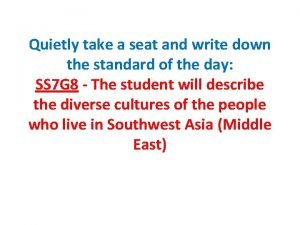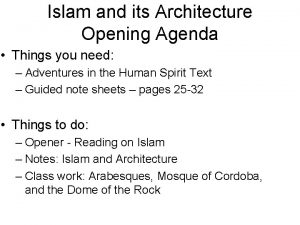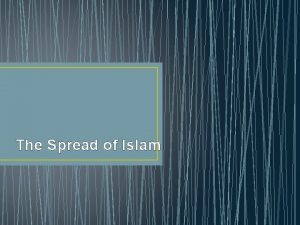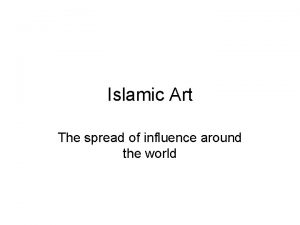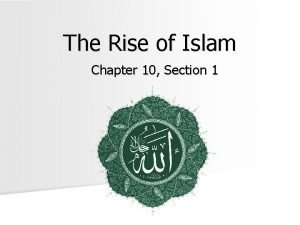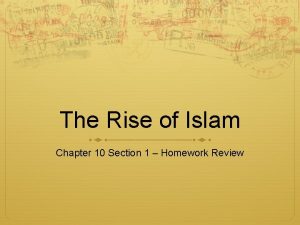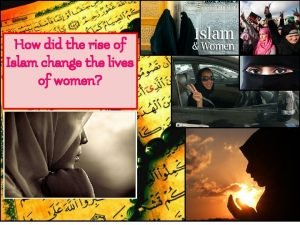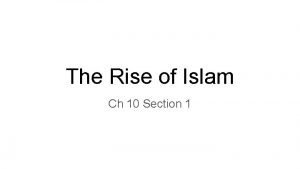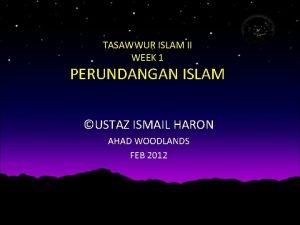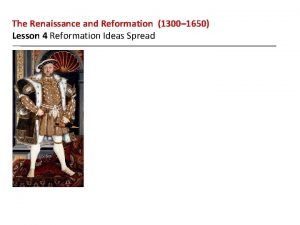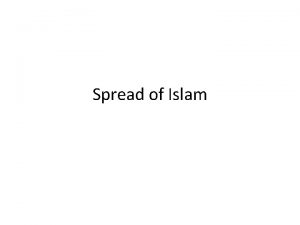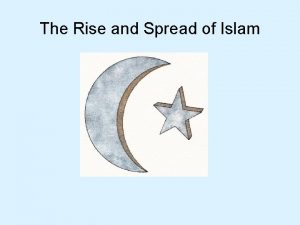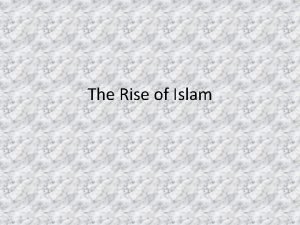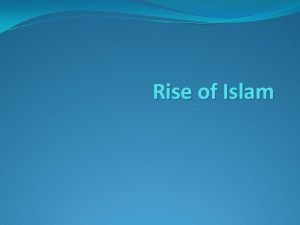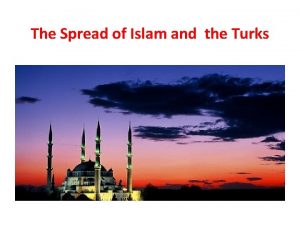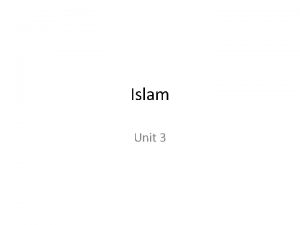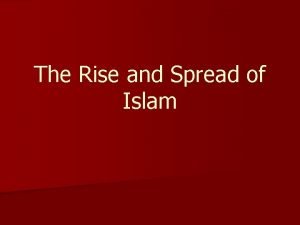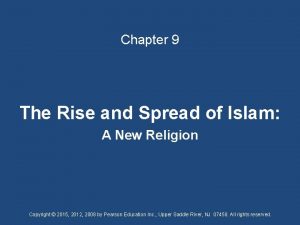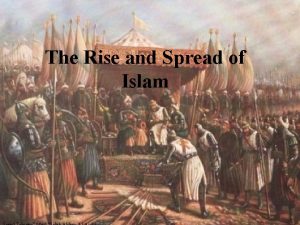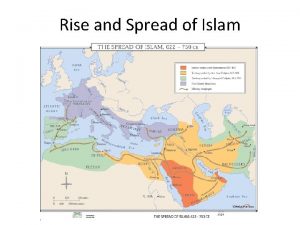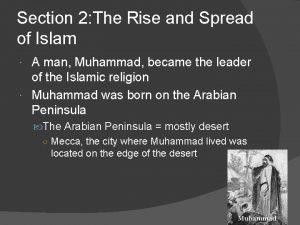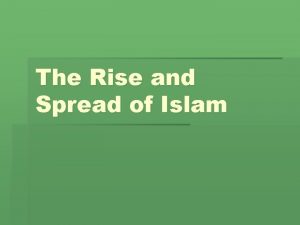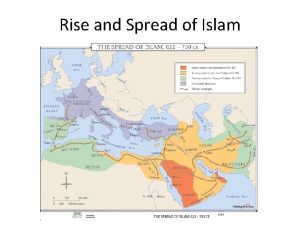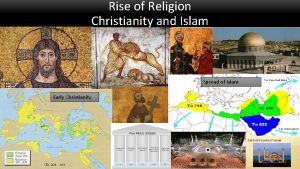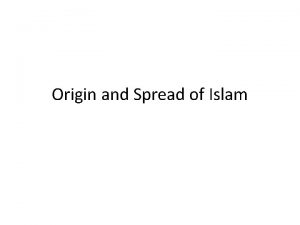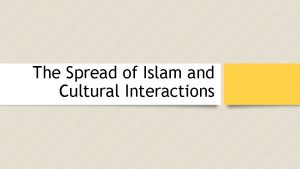Unit 2 The Rise and Spread of Islam


























- Slides: 26

Unit 2: The Rise and Spread of Islam Day 4: THe Arab Empire & Caliphates

Early Teachings –Muhammad began preaching Islam in Mecca, but was met with resistance • Local leaders believed Muhammad to be a threat to their power • Feared Mecca would lose its role as a pilgrimage location

–As a result Muhammad decided to flee Mecca • Hijrah: Migration of Muhammad and his followers from Mecca to Medina (“city of the Prophet”) in 622 • Became a political, religious, and military leader

Return to Mecca • In 630 returns with 10, 000 men • The city surrenders and converts to Islam • By 632 Islam has spread across the Arabian peninsula

Rise of the Caliphs —Muhammad dies without a successor, —Muslim community elected leaders, known as caliphs (political/spiritual leaders) • The area controlled by the caliph was known as the caliphate • Governed by shari’ah law- based on the Qur’an and Muhammed’s life to guide daily life

—Caliphs following Muhammad’s death: Abu. Bakr, Umar, Uthman, and Ali • Continued to expand the influence of Islam by using strong military force • Spread into the Fertile Crescent, Iran, and Central Asia as the Byzantine and Persian empires became weaker creating an Islamic Empire

End of the Caliphs o. Ali was assassinated in 661 over a struggle for power o. Umayyad family began to divide Muslim community

The Umayyads • Mu’awiyah, governor of Syria became caliph • Moved the capital from Medina to Damascus (modern-day Syria) • Conquered and converted the Berbers in N Africa • Crossed into Spain and was finally stopped at the Battle of Tours 732 in Gaul (France)


Islam Splits • Hussein (2 nd son of Ali) opposed the Umayyad interpretation of the Caliphs • Led to the formation of two parties – Sunnis: ▪ Believed that the caliph should be chosen from among the umma o Shi’a (Shiites): ▪ Believed Ali and his heirs were the rightful successors to Muhammad

Abbasid Caliphate 7501258 • Moved the capital to Baghdad - more central to trade in the region • Ruled over the Islamic Golden Ageprosperous era when many significant Islamic contributions were made



Fatimid Dynasty – Independent kingdoms began to arise in the Abbasid Empire – Rival dynasty that controlled North Africa and the southern part of the Arabian Peninsula

Seljuk Turks • Nomads from Central Asia had converted to Islam • Served as soldiers under the Abbasid • As the Abbasid weakened the Turks took Baghdad and most of Asia Minor

Ottoman Turks • Originally vassals of the Seljuk Turks • Formed their own state in 1280 • After Mongol occupation of the Middle East the Ottomans were able to defeat the Byz Empire and take parts of SE Europe


Islamic Contributions Why is this important? – Kept learning alive during the Dark Ages (after the fall of the Roman Empire)

- Introduction o As the Islamic Empire grew, more and more people came into contact with one another o This cultural diffusion led to many advances

o Dome of the Rock - Architecture This site is sacred to ▪ Islamic shrine on the both Jewish and Islamic Temple Mount in people, therefore it is Jerusalem ▪ Dome structure similar the cause of a great to Persian, Greek, and deal of current strife Byzantine architecture. ▪ Believed to be the spot from which Muhammad ascended to heaven

- Education o Desire to discover the truth and develop a practical understanding of the world o House of Wisdom (Baghdad, Iraq) ▪ Early university ▪ Library, school, & translation center ▪ Brought together people from all over the world ▪ Site of most Muslim learning ▪ Translated texts from Greece, India, & Persia

- Medicine o Al-Razi: Persian physician ▪ Wrote comprehensive Book of Medicine, that combines medical knowledge from Greece, Arabia, & India ▪ Believed patients would recover faster if they breathed clean air • Influenced location of early hospitals

- Mathematics You’re Welcome! o Al- Khwarizmi: developed algebra (Al-jabr- “the addition of one thing to another”) ▪ Based his ideas on those of Aristotle & Indian mathematicians o Adapted Indian numbering system ▪ Concept of zero

- Art o Created mosaics and wrote in calligraphy ▪ No depictions of Allah or Muhammad

o Developed the Arabic language & alphabet ▪ 2 nd most used language in the world ▪ Only language considered to be the true language of Allah. - Language

Why were these Islamic cultural contributions important?
 Tricky dick: the rise and fall and rise of richard m. nixon
Tricky dick: the rise and fall and rise of richard m. nixon Rise and rise again
Rise and rise again Rise and rise again until lambs become lions
Rise and rise again until lambs become lions A union b example
A union b example Dbq essay outline
Dbq essay outline Spread of islam through architecture exit slip
Spread of islam through architecture exit slip Spread betting fx
Spread betting fx Spread betting islam
Spread betting islam Spread betting islam
Spread betting islam Islam beliefs and practices
Islam beliefs and practices The rise of islam chapter 10 section 1
The rise of islam chapter 10 section 1 How did the rise of islam change the lives of women?
How did the rise of islam change the lives of women? Rise of islam timeline
Rise of islam timeline The rise of islam chapter 10 section 1
The rise of islam chapter 10 section 1 Faedah mengamalkan perundangan islam
Faedah mengamalkan perundangan islam Kesimpulan islam
Kesimpulan islam Kesan perkembangan ilmu pada zaman abbasiyah
Kesan perkembangan ilmu pada zaman abbasiyah Unit 12 lesson 4 reformation ideas spread
Unit 12 lesson 4 reformation ideas spread Unit 6 review questions
Unit 6 review questions Hình ảnh bộ gõ cơ thể búng tay
Hình ảnh bộ gõ cơ thể búng tay Frameset trong html5
Frameset trong html5 Bổ thể
Bổ thể Tỉ lệ cơ thể trẻ em
Tỉ lệ cơ thể trẻ em Gấu đi như thế nào
Gấu đi như thế nào Chụp phim tư thế worms-breton
Chụp phim tư thế worms-breton Hát lên người ơi alleluia
Hát lên người ơi alleluia Môn thể thao bắt đầu bằng chữ f
Môn thể thao bắt đầu bằng chữ f




